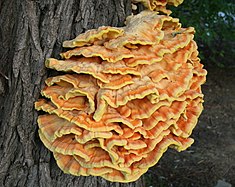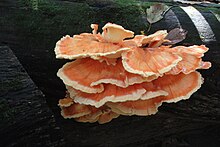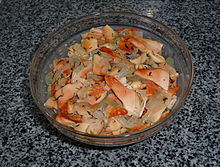Laetiporus
Laetiporus | |
|---|---|
 | |
L. sulphureus in Belgium | |
Scientific classification | |
| Kingdom: | Fungi |
| Division: | Basidiomycota |
| Class: | Agaricomycetes |
| Order: | Polyporales |
| Family: | Fomitopsidaceae |
| Genus: | Laetiporus Murr. (1904) |
Type species | |
Laetiporus speciosus Battarra ex Murrill (1904) | |
Laetiporus is a genus of edible mushrooms found throughout much of the world. Some species, especially Laetiporus sulphureus, are commonly known as sulphur shelf, chicken of the woods, the chicken mushroom, or the chicken fungus because many think they taste like chicken. The name "chicken of the woods" is not to be confused with the edible polypore, Maitake (Grifola frondosa) known as "hen of the woods", or with Lyophyllum decastes, known as the "fried chicken mushroom". The name Laetiporus means "with bright pores".[1]
Contents
1 Description
2 Phylogenetics
3 Edibility
4 Species
5 See also
6 References
7 External links
Description

Laetiporus sp. from Anamalai Hills, Southern Western Ghats, India
Individual "shelves" range from 5 cm to 25 cm (2"-10" inches) across. These shelves are made up of many tiny tubular filaments (hyphae). The mushroom grows in large brackets - some have been found that weigh over 45 kg (100 pounds). It is most commonly found on wounds of trees, mostly oak, though it is also frequently found on eucalyptus, yew, sweet chestnut, and willow, as well as conifers in some species. Laetiporus species are parasitic and produce brown rot in the host on which they grow.
Young fruiting bodies are characterized by a moist, rubbery, sulphur-yellow to orange body sometimes with bright orange tips. Older brackets become pale and brittle almost chalk like, mildly pungent, and are often dotted with beetle or slug/woodlouse holes. Similar species include Laetiporus gilbertsonii (fluorescent pink, more amorphous) and L. coniferica (common in the western United States, especially on red fir trees).[2] Edibility traits for the different species have not been well documented, although all are generally considered edible with caution.[citation needed]
The sulphur shelf mushroom sometimes comes back year after year when the weather suits its sporulation preferences. From late spring to early autumn, the sulphur shelf thrives, making it a boon to mushroom hunters and a bane to those concerned about the health of their trees. This fungus causes a brown cubical rot and embrittlement which in later stages ends in the collapse of the host tree, as it can no longer flex and bend in the wind.[citation needed]

Chicken of the Woods (Laetiporus cincinnatus) in Prospect Park, Brooklyn, New York on October 5, 2012.
Phylogenetics

L. cincinnatus, Ohio, US
Phylogenetic analyses of ITS, nuclear large subunit and mitochondrial small subunit rDNA sequences from a variety of North American species have delineated five distinct clades within the core Laetiporus clade: sulphureus clade I contains white-pored L. sulphureus isolates, while sulphureus clade II contains yellow-pored L. sulphureus isolates.[3]
In addition, phylogenetic clades have been identified from Japan, Hawaii, South America, Europe, and South Africa.[4]
Edibility
The mushroom can be prepared in most ways that one can prepare chicken meat. It can also be used as a substitute for chicken in a vegetarian diet. Additionally, it can be frozen for long periods of time and retain its edibility. In certain parts of Germany and North America, it is considered a delicacy.

L. sulphureus prepared dish
In some cases eating the mushroom "causes mild reactions . . . for example, "swollen lips" or in rare cases "nausea, vomiting, dizziness and disorientation" to those who are sensitive.[5] This is believed to be due to a number of factors that include allergies to the mushroom's protein or toxins which are only somewhat stable at high temperatures. As such, many field guides request that those who eat Laetiporus exercise caution by only eating fresh, young brackets and begin with small quantities to see how well it sits in their stomach.
Laetiporus sulphureus has a potent ability to inhibit staph bacteria (Staphylococcus aureus), as well as moderate ability to inhibit the growth of Bacillus subtilis.[6]
Species
Laetiporus ailaoshanensis[7]B.K.Cui & J.Song (2014)
Laetiporus baudonii (Pat.) Ryvarden (1991)
Laetiporus caribensis Banik & D.L.Lindner (2012)
Laetiporus cincinnatus (Morgan) Burds., Banik & T.J.Volk (1998)
Laetiporus conifericola Burds. & Banik (2001)
Laetiporus cremeiporus Y.Ota & T.Hatt. (2010)
Laetiporus discolor (Klotzsch) Corner (1984)
Laetiporus flos-musae Overeem (1927)
Laetiporus gilbertsonii Burds. (2001)
Laetiporus huroniensis Burds. & Banik (2001)
Laetiporus miniatus (P.Karst.) Overeem (1925)
Laetiporus montanus Černý ex Tomšovský & Jankovský (2009)
Laetiporus persicinus (Berk. & M.A.Curtis) Gilb. (1981)
Laetiporus portentosus (Berk.) Rajchenb. (1995)
Laetiporus squalidus R.M.Pires, Motato-Vásq. & Gugliottta (2016)[8]
Laetiporus sulphureus (Bull.) Murrill (1920)
Laetiporus zonatus[7]B.K.Cui & J.Song (2014)
See also
- List of meat substitutes
 Food portal
Food portal
 Fungi portal
Fungi portal
References
^ Smith, Alexander H.; Smith Weber, Nancy (1980). The Mushroom Hunter's Field Guide. University of Michigan Press. p. 64. ISBN 978-0-472-85610-7..mw-parser-output cite.citation{font-style:inherit}.mw-parser-output .citation q{quotes:"""""""'""'"}.mw-parser-output .citation .cs1-lock-free a{background:url("//upload.wikimedia.org/wikipedia/commons/thumb/6/65/Lock-green.svg/9px-Lock-green.svg.png")no-repeat;background-position:right .1em center}.mw-parser-output .citation .cs1-lock-limited a,.mw-parser-output .citation .cs1-lock-registration a{background:url("//upload.wikimedia.org/wikipedia/commons/thumb/d/d6/Lock-gray-alt-2.svg/9px-Lock-gray-alt-2.svg.png")no-repeat;background-position:right .1em center}.mw-parser-output .citation .cs1-lock-subscription a{background:url("//upload.wikimedia.org/wikipedia/commons/thumb/a/aa/Lock-red-alt-2.svg/9px-Lock-red-alt-2.svg.png")no-repeat;background-position:right .1em center}.mw-parser-output .cs1-subscription,.mw-parser-output .cs1-registration{color:#555}.mw-parser-output .cs1-subscription span,.mw-parser-output .cs1-registration span{border-bottom:1px dotted;cursor:help}.mw-parser-output .cs1-ws-icon a{background:url("//upload.wikimedia.org/wikipedia/commons/thumb/4/4c/Wikisource-logo.svg/12px-Wikisource-logo.svg.png")no-repeat;background-position:right .1em center}.mw-parser-output code.cs1-code{color:inherit;background:inherit;border:inherit;padding:inherit}.mw-parser-output .cs1-hidden-error{display:none;font-size:100%}.mw-parser-output .cs1-visible-error{font-size:100%}.mw-parser-output .cs1-maint{display:none;color:#33aa33;margin-left:0.3em}.mw-parser-output .cs1-subscription,.mw-parser-output .cs1-registration,.mw-parser-output .cs1-format{font-size:95%}.mw-parser-output .cs1-kern-left,.mw-parser-output .cs1-kern-wl-left{padding-left:0.2em}.mw-parser-output .cs1-kern-right,.mw-parser-output .cs1-kern-wl-right{padding-right:0.2em}
^ Burdsall, Jr., Harold H.; Banik, Mark T. (2001). "The genus Laetiporus in North America" (PDF). Harvard Papers in Botany. 6 (1): 43–55.
^ Lindner, D.L.; Banik, M.T. (2008). "Molecular phylogeny of Laetiporus and other brown rot polypore genera in North America". Mycologia. 100 (3): 417–430. doi:10.3852/07-124R2. PMID 18751549.
^ Banik, Mark T.; Lindner, Daniel L.; Ota, Yuko; Hattori, Tsutomu (2010). "Relationships among North American and Japanese Laetiporus isolates inferred from molecular phylogenetics and single-spore incompatibility reactions". Mycologia. 102 (4): 911–917. doi:10.3852/09-044. PMID 20648757.
^ Michael W. Beug. "Poisonous and hallucinogenic mushrooms". Retrieved Feb 21, 2013.
^ Suay I, Arenal F, Asensio FJ, Basilio A, Cabello MA, Díez MT, García JB, del Val AG, Gorrochategui J, Hernández P, Peláez F, Vicente MF (Aug 2000). "Screening of basidiomycetes for antimicrobial activities". Antonie van Leeuwenhoek. 78 (2): 129–139. doi:10.1023/A:1026552024021. PMID 11204765.
^ ab Song, Jie; Chen, yuanyuan; Cui, Baokai (2014). "Morphological and molecular evidence for two new species of Laetiporus (Basidiomycota, Polyporales) from southwestern China". Mycologia. 106 (5): 1039–1050. doi:10.3852/13-402. PMID 24987130.
^ Pires, Ricardo Matheus; Motato-Vásquez, Viviana; de Mello Gugliotta, Adriana (2016). "A new species of Laetiporus (Basidiomycota) and occurrence of L. gilbertsonii Burds. in Brazil". Nova Hedwigia. 102 (3–4): 477–490. doi:10.1127/nova_hedwigia/2016/0320.
External links
 Media related to Laetiporus at Wikimedia Commons
Media related to Laetiporus at Wikimedia Commons- Mushroom-Collecting.com - Laetiporus

Comments
Post a Comment